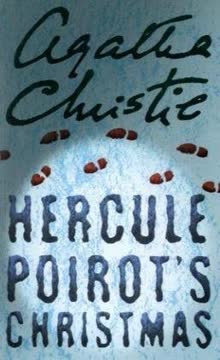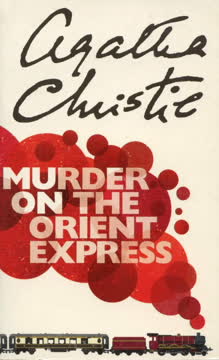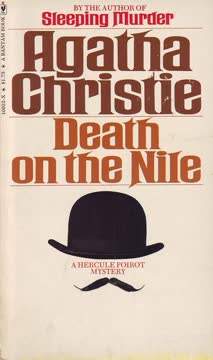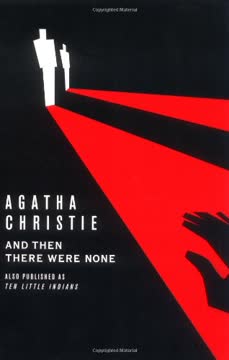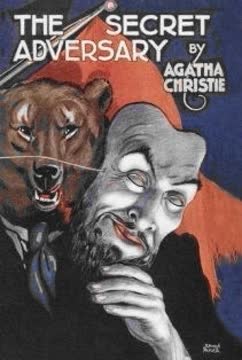Plot Summary
Homecoming in the Fog
As Christmas approaches, the Lee family patriarch, Simeon Lee, summons his scattered children to Gorston Hall for a rare family gathering. The arrivals are fraught with tension: Alfred, the dutiful son, and his wife Lydia; George, the pompous MP, and his glamorous wife Magdalene; David, the sensitive artist, and his strong-willed wife Hilda; and Harry, the prodigal son, returning after decades abroad. Two outsiders join: Stephen Farr, a South African stranger with a mysterious connection, and Pilar Estravados, the Spanish granddaughter. Each arrival brings old resentments and secrets, setting the stage for a volatile reunion.
The Lee Family Summoned
Simeon Lee, once a ruthless adventurer, now a frail but domineering invalid, delights in controlling his family. He insists on their presence, hinting at changes to his will and introducing unexpected guests. The family's unease grows as old wounds are reopened: David's bitterness over his mother's suffering, George's greed, Harry's disgrace, and Lydia's quiet resistance. Simeon's gamesmanship is clear—he enjoys pitting his children against each other, stoking rivalries and suspicions, all under the guise of Christmas cheer.
Strangers at the Table
Pilar, exotic and enigmatic, and Stephen, observant and self-assured, unsettle the Lees. Pilar's presence is a reminder of the family's lost daughter, Jennifer, and her mysterious Spanish past. Stephen's connection to Simeon's South African days is ambiguous, arousing curiosity and suspicion. Both outsiders are watched closely, their motives questioned. The family's discomfort is heightened by the knowledge that Simeon keeps a fortune in uncut diamonds in his bedroom safe—a tempting prize for any opportunist.
Old Sins, New Wounds
Conversations reveal the family's deep fractures. David cannot forgive his father for his mother's misery. Alfred is trapped by duty, Lydia by her outsider status. George and Magdalene are anxious about money, while Harry's return is met with hostility. Simeon's past—his affairs, illegitimate children, and ruthless business dealings—casts a long shadow. The atmosphere is thick with suspicion, envy, and unresolved pain, as each character wonders what Simeon truly wants and what he might do next.
The Tyrant's Last Christmas
On Christmas Eve, Simeon gathers the family, taunting them with talk of his will and their shortcomings. He insults each in turn, sowing discord and hinting that he may have other heirs, perhaps even illegitimate ones. He also reports the theft of his diamonds to the police, summoning Superintendent Sugden under a false pretext. The family disperses, each member stewing in anger or anxiety. Simeon, alone in his room, handles his diamonds and relishes the chaos he has created.
A Locked Room, A Scream
Suddenly, a terrible crash and a bloodcurdling scream echo through the house. The family rushes to Simeon's locked bedroom, forced to break down the door. Inside, they find a scene of carnage: Simeon Lee lies dead, his throat savagely cut, the room in violent disarray, blood everywhere. The windows are locked, the door was secured from the inside, and the murder weapon is missing. The family is stunned, and suspicion immediately falls on everyone present.
Blood and Shadows
Superintendent Sugden takes charge, joined by Hercule Poirot, who is visiting the local chief constable. The locked-room puzzle baffles all: how did the killer escape? The family's alibis are shaky, and the servants' movements are scrutinized. The missing diamonds add another layer of intrigue. Poirot observes the family's reactions, noting their fear, anger, and evasions. He is struck by the abundance of blood and the sense that the crime was staged for maximum shock.
Poirot Joins the Hunt
Poirot interviews each family member and guest, probing their relationships with Simeon and each other. He notes the psychological scars: David's obsession with his mother's suffering, Hilda's protective strength, Lydia's intelligence, Magdalene's duplicity, and Harry's bravado. The outsiders, Pilar and Stephen, are enigmatic, their backgrounds unclear. Poirot is particularly interested in the family's resemblance to Simeon, both in appearance and temperament, and in the possibility of an unknown heir.
Diamonds and Deceptions
The missing diamonds become a focal point. Was the murder committed for gain, or as an act of revenge? Pilar's identity is questioned, and Stephen's story is suspect. Poirot discovers the diamonds hidden in Lydia's garden, suggesting an inside job. Meanwhile, Pilar narrowly escapes a booby-trap meant to kill her, indicating the murderer is still at large and desperate. The web of lies and secrets grows ever more tangled.
The Family Fractures
The Lees turn on each other, each suspecting the others. Old grievances resurface, and alliances shift. Poirot points out that every member had motive and opportunity, and that the crime's brutality suggests deep-seated hatred. The possibility of an illegitimate child—another Lee—haunts the investigation. The family's unity dissolves, replaced by fear and mutual distrust. Poirot warns that the truth lies in understanding Simeon's character and legacy.
Ghosts and Doppelgängers
Poirot notices uncanny similarities between Harry, Stephen, and even Superintendent Sugden—gestures, features, and mannerisms that echo Simeon Lee's youth. The butler, Tressilian, is confused by the likenesses, feeling as if the past is repeating itself. Poirot realizes that the murderer may be a Lee by blood, but not by name—a hidden son, driven by resentment and a desire for revenge. The locked-room trick, the staged violence, and the abundance of blood all point to a carefully planned crime.
The Truth in the Blood
Poirot gathers everyone and reveals his deductions. The murder was committed before the supposed time of death; the scene was staged with a cord, a bottle of animal blood, and a "dying pig" balloon to create the illusion of a struggle and a delayed scream. The killer locked the door from the outside and triggered the chaos remotely. The key clue: the murderer is Simeon Lee's illegitimate son, who shares his features and temperament. Poirot unmasks Superintendent Sugden as the killer, motivated by long-held resentment against the father who abandoned him.
The Trap Springs Again
Sugden, desperate to cover his tracks, tries to kill Pilar, who had unwittingly picked up a vital clue—a piece of the balloon used in the murder. A booby-trapped cannonball nearly kills her, but she survives. Poirot's psychological insight and attention to detail expose Sugden's plot, his false alibi, and his true identity. The family is left reeling by the revelation that the murderer was among them all along, hidden in plain sight.
The Unmasking
Sugden confesses, his pride and hatred laid bare. He is arrested, and the family must confront the reality of their father's legacy: a life of manipulation, cruelty, and secret sins that bred violence and tragedy. The Lees are forced to reckon with their own flaws and the ways in which they have been shaped by Simeon's influence. Poirot's intervention brings justice, but not peace—the wounds are too deep for easy healing.
Aftermath and Forgiveness
In the aftermath, the Lees decide to divide the inheritance fairly, including Pilar, who reveals she is not truly Jennifer's daughter but an imposter who came to England for a better life. Stephen, too, is revealed as an illegitimate son, but innocent of the crime. The family disperses, each seeking a fresh start: Harry leaves for Hawaii, David and Hilda find peace, Lydia and Alfred plan a new life together, and Pilar and Stephen plan to marry. Poirot departs, reflecting on the darkness at the heart of families and the possibility of redemption.
Characters
Hercule Poirot
Poirot is the celebrated Belgian detective whose methodical approach and psychological insight unravel the mystery. He is fascinated by character and motive, believing that understanding the victim is key to solving the crime. Poirot's empathy, attention to detail, and ability to see through lies allow him to penetrate the family's web of secrets. He is both outsider and confessor, drawing out confessions and truths that others would rather keep hidden. His presence brings both relief and discomfort, as he exposes the darkness beneath the surface.
Simeon Lee
Simeon is a former adventurer, diamond magnate, and womanizer, now a frail but domineering invalid. He delights in controlling and tormenting his family, pitting them against each other for his own amusement. His past is littered with betrayals, affairs, and illegitimate children. Simeon's cruelty and pride have left deep scars on his children, shaping their lives and relationships. His murder is both a personal reckoning and the culmination of decades of unresolved pain.
Alfred Lee
Alfred is the dutiful son who has sacrificed his own happiness to serve his father. He is gentle, loyal, and emotionally stunted, trapped by obligation and unable to assert himself. His marriage to Lydia is a source of stability, but he is haunted by a sense of inadequacy and resentment. Alfred's relationship with his siblings is strained, especially with Harry, whose return threatens his fragile sense of order.
Lydia Lee
Lydia, Alfred's wife, is sharp, creative, and quietly rebellious. She is an outsider in the Lee family, both by birth and temperament, and often serves as the voice of reason. Lydia is perceptive, unafraid to speak the truth, and deeply loyal to Alfred. She is also the only family member to see the need for justice and closure, even at the cost of further pain.
Harry Lee
Harry is the black sheep, a charming but unreliable adventurer who has spent years abroad. He is physically similar to his father, sharing his looks and mannerisms, but lacks Simeon's discipline and cunning. Harry's return stirs up old animosities, especially with Alfred, and his presence is a catalyst for the family's unraveling. Despite his bravado, Harry is ultimately weak and self-serving.
George Lee
George is the self-important MP, obsessed with money and status. He is married to Magdalene, whose beauty and extravagance he both resents and relies upon. George is cautious, calculating, and easily rattled. His relationship with his father is transactional, and he is quick to suspect and accuse others when his inheritance is threatened.
Magdalene Lee
Magdalene is George's much younger wife, a social climber with a mysterious past. She is skilled at using her looks and charm to get what she wants, but is also insecure and fearful of exposure. Magdalene's duplicity and self-interest make her both a suspect and a victim of the family's dysfunction.
David Lee
David is the youngest son, a gentle, artistic soul traumatized by his mother's suffering. He is emotionally fragile, dependent on his wife Hilda, and unable to forgive his father. David's relationship with the family is distant, and he is tormented by guilt and unresolved anger. His journey is one of healing and release from the past.
Hilda Lee
Hilda, David's wife, is solid, practical, and fiercely protective. She is the emotional anchor for David, helping him confront his trauma and find peace. Hilda's strength and moral clarity make her a formidable presence, and she is willing to do whatever it takes to shield her husband from harm.
Pilar Estravados (Conchita Lopez)
Pilar is introduced as Simeon's Spanish granddaughter, but is later revealed to be an imposter who assumed Pilar's identity after the real Pilar died in Spain. She is clever, adaptable, and unashamed of her deception, motivated by a desire for a better life. Pilar's outsider status and ambiguous morality make her both a suspect and a catalyst for the truth.
Stephen Farr (Stephen Grant)
Stephen arrives as the son of Simeon's old partner, but is later revealed to be another of Simeon's illegitimate children. He is intelligent, observant, and driven by a need to understand his origins. Stephen's resemblance to the Lee men is a key clue, and his presence forces the family to confront the consequences of Simeon's past.
Superintendent Sugden
Sugden is the local police superintendent, initially seen as a competent and impartial investigator. In reality, he is Simeon's illegitimate son, consumed by resentment and a desire for revenge. Sugden's meticulous planning, use of disguise, and psychological insight make him a formidable adversary. His crime is both a personal vendetta and a symbolic act of retribution against the father who abandoned him.
Plot Devices
Locked Room Mystery
The central plot device is the locked-room murder: Simeon Lee is found dead in a room locked from the inside, with no apparent means of escape for the killer. The elaborate staging—overturned furniture, a bloodcurdling scream, and missing weapon—creates an apparently insoluble puzzle. Poirot's unraveling of the trick (a delayed "scream," staged struggle, and remote locking) is a masterclass in misdirection and logical deduction.
Family Resemblance and Inheritance
The theme of family resemblance—physical, psychological, and moral—is woven throughout. Poirot's observation of shared features and gestures among the men leads him to suspect the presence of an unacknowledged son. The question of inheritance, both financial and emotional, drives the plot and provides motive for multiple characters.
False Identities and Imposture
Several characters are not who they seem: Pilar is an imposter, Stephen is an illegitimate son, and Sugden hides his true parentage. These deceptions create layers of suspicion and misdirection, challenging both the characters and the reader to discern truth from appearance.
Psychological Analysis
Poirot's method relies on understanding the victim and suspects as psychological beings. He probes their histories, traumas, and desires, believing that the solution lies not in physical evidence alone but in the interplay of character and motive. This approach allows him to see through alibis and lies to the emotional truth at the heart of the crime.
Foreshadowing and Symbolism
Christie uses foreshadowing—references to blood, violence, and family secrets—to prepare the reader for the revelation. The abundance of blood, the "dying pig" balloon, and the recurring motif of doppelgängers all serve as symbolic clues. The locked room, the missing diamonds, and the booby-trap are not just plot devices but metaphors for the family's entrapment and the explosive consequences of buried secrets.
Analysis
Hercule Poirot's Christmas is a masterful exploration of family dysfunction, the legacy of abuse, and the destructive power of secrets. Christie uses the locked-room mystery not just as a puzzle, but as a metaphor for the emotional prisons her characters inhabit. The novel interrogates the idea of inheritance—not just of wealth, but of trauma, pride, and resentment. Simeon Lee's cruelty reverberates through generations, shaping his children's lives and ultimately leading to his own violent end. The presence of imposters and hidden heirs underscores the instability of identity and the dangers of denial. Poirot's psychological approach—his insistence on understanding character and motive—offers a model for empathy and insight, suggesting that true justice requires more than the mere solving of puzzles. In the end, the novel is both a thrilling whodunit and a meditation on the ways in which the past haunts the present, and how forgiveness and self-knowledge are the only paths to healing.
Last updated:
FAQ
Synopsis & Basic Details
What is Hercule Poirot's Christmas about?
- A Dysfunctional Family Reunion: Wealthy and tyrannical patriarch Simeon Lee summons his estranged children and their families to his country estate, Gorston Hall, for a Christmas gathering, ostensibly for reconciliation but truly to torment them and stir up old resentments.
- A Brutal Locked Room Mystery: On Christmas Eve, after a provocative family meeting where Simeon threatens to alter his will and insults everyone, a violent struggle is heard from his locked bedroom, followed by a bloodcurdling scream. The family breaks down the door to find Simeon dead, his throat cut, in a room seemingly impossible for a killer to escape.
- Poirot's Psychological Analysis: Hercule Poirot, visiting the local Chief Constable, is called in to investigate. He delves into the family's complex history, hidden motives, and the victim's manipulative character, unraveling a web of lies, false identities, and a meticulously staged crime to expose a killer driven by a deep-seated, long-held desire for revenge.
Why should I read Hercule Poirot's Christmas?
- A "Good Violent Murder": Written as a direct response to a brother-in-law's request for a more "violent murder with lots of blood," this novel delivers on that promise, offering a stark contrast to Christie's often "anaemic" poisonings, making it a unique entry in her Poirot canon.
- Masterful Locked Room Puzzle: Christie expertly crafts an impossible crime, challenging readers with a seemingly impenetrable mystery that involves a locked room, a staged struggle, and a missing weapon, all meticulously explained by Poirot's "little grey cells."
- Deep Psychological Analysis: Beyond the puzzle, the novel delves into the corrosive effects of family dysfunction, the weight of the past, and the complex motivations of characters shaped by a domineering patriarch, offering rich psychological insights into human nature and the nature of revenge.
What is the background of Hercule Poirot's Christmas?
- Author's Personal Challenge: Agatha Christie dedicated the book to her brother-in-law, James Watts, who desired a "good violent murder with lots of blood." This personal challenge influenced the novel's brutal nature and its departure from some of her more "refined" methods of murder.
- Subversion of Christmas Tropes: The novel deliberately subverts the traditional "peace and goodwill" associated with Christmas, instead using the festive setting to highlight family discord, greed, and long-simmering hatred, making the holiday a backdrop for tragedy rather than joy.
- Exploration of Family Resemblance and Inheritance: The story deeply explores themes of heredity, both physical and psychological, and the lasting impact of a patriarch's actions on his descendants. Simeon Lee's past, including his illegitimate children, directly drives the plot and the ultimate revelation of the killer.
What are the most memorable quotes in Hercule Poirot's Christmas?
- "Yet who would have thought the old man to have had so much blood in him?" (Macbeth, Lady Macbeth): This epigraph, and Lydia Lee's later utterance of it, immediately sets a tone of brutal violence and foreshadows the shocking amount of blood at the crime scene, hinting at a deeper, almost ritualistic aspect to the murder.
- "Take what you like and pay for it, says God." (Spanish Proverb): Pilar Estravados (Conchita Lopez) shares this proverb with Simeon Lee, who initially embraces it as justification for his life of excess. Her follow-up question, "And you have paid for it?", profoundly unsettles him, encapsulating the novel's central theme of reckoning and the inescapable consequences of one's actions.
- "The mills of God grind slowly, yet they grind exceeding small." (Henry Wadsworth Longfellow): David Lee quotes this line upon seeing his father's body, and Poirot later references it. It powerfully articulates the theme of delayed but inevitable retribution, suggesting that Simeon's death is a long-overdue consequence of his past cruelties and manipulations.
What writing style, narrative choices, and literary techniques does Agatha Christie use?
- Classic Detective Story Structure with Subversion: Christie employs the traditional country house mystery and locked-room puzzle, but subverts expectations with the sheer brutality of the murder and the psychological depth of the family's dysfunction, moving beyond a mere intellectual exercise.
- Poirot's Psychological Acumen: The narrative heavily relies on Poirot's unique method, emphasizing "the eyes of the mind" over purely physical evidence. His "conversations" rather than interrogations are a key narrative choice, designed to elicit unconscious truths and reveal character, which he believes is paramount to understanding the crime.
- Foreshadowing and Symbolism: Christie masterfully uses subtle clues, repeated observations (like Tressilian's déjà vu or the physical resemblances), and seemingly throwaway lines (like Pilar's "cut my enemy's throat") to build a complex web of foreshadowing that only becomes clear in retrospect, rewarding careful readers.
Hidden Details & Subtle Connections
What minor details foreshadow the killer's identity?
- Sugden's Physical Resemblance to Simeon: Early descriptions of Superintendent Sugden, particularly his "aquiline nose, a pugnacious jaw and a large flourishing chestnut-coloured moustache" (Part 3, Section VI), subtly echo the portrait of young Simeon Lee and Harry's features, hinting at a shared lineage long before the reveal.
- Pilar's Unsettling Compliment to Sugden: Pilar's naive observation, "when he was a young man, he must have been handsome – very handsome, like you," directed at Sugden (Part 4, Section XIV), is a moment of accidental truth that visibly discomfits the Superintendent, revealing his hidden connection to Simeon.
- Tressilian's "Déjà Vu" Experience: The butler Tressilian's repeated feeling that "the past isn't the past!" and his confusion between Harry Lee and Stephen Farr (Part 4, Section XVI) is a crucial, yet easily overlooked, clue. It highlights the striking physical similarities among Simeon's sons, both legitimate and illegitimate, which Poirot later uses to identify Sugden.
How does the "Dead Sea" garden symbolize the Lee family's state?
- Aridity and Emotional Barrenness: Lydia's "Dead Sea" garden, described as "rather arid" and "not meant to be specially attractive" (Part 1, Section III), symbolizes the emotional barrenness and lack of genuine warmth within the Lee family, a direct consequence of Simeon's tyrannical nature.
- Hidden Value Amidst Desolation: The discovery of the uncut diamonds hidden within the Dead Sea garden (Part 5, Section I) represents the hidden, often corrupted, value and potential within the family, buried beneath layers of resentment and emotional desolation, yet still a source of conflict and desire.
- Lydia's Unfinished Creation: The garden being "not finished yet" (Part 4, Section IV) reflects Lydia's own struggle to cultivate genuine beauty and peace amidst the family's toxic environment, and her eventual desire to create a "Garden of Eden" without a serpent, symbolizing a hope for a new, healthier beginning.
What is the significance of the recurring "bell ringing" motif?
- Echoes of the Past and Repetition: The aggressive pealing of the doorbell, first for Harry Lee and then for Stephen Farr, causes Tressilian to feel a sense of "déjà vu" (Part 2, Section I; Part 2, Section IV), subtly signaling the repetitive nature of Simeon's past actions (his affairs, his sons) and the cyclical pattern of conflict within the family.
- Disruption and Impatience: The "unusually aggressive peal" of the bell (Part 2, Section I) consistently marks the arrival of disruptive forces or significant events, reflecting the impatience and forceful nature of those entering Simeon's orbit, particularly his unacknowledged sons.
- Tressilian's Sensory Decline as a Clue: Tressilian's confusion and feeling of "mixing things up" (Part 5, Section III) due to his failing eyesight, triggered by the similar appearances of the men arriving, is a subtle clue to Poirot about the physical resemblances that are central to the killer's identity, highlighting how sensory details can be crucial.
Psychological, Emotional, & Relational Analysis
What are some unspoken motivations of the characters?
- Simeon's Fear of Irrelevance: Beyond mere sadism, Simeon's constant manipulation and provocation of his family, especially his taunts about his will and illegitimate children, stem from a deep-seated fear of irrelevance and a desire to exert control and leave a lasting, albeit destructive, mark even in his old age. He wants to be the "focus and centre of the mystery!" (Part 6, Section VI).
- Alfred's Desire for Paternal Approval: Alfred's "selfless devotion" and "subordinated" nature (Part 6, Section VI) mask a profound, unspoken desire for his father's approval, which Simeon consistently withheld. This creates a fertile ground for suppressed resentment, making him a "psychologically possible criminal" in Poirot's initial assessment.
- Magdalene's Desperate Social Climbing: Magdalene's "meretricious airs and graces" (Part 3, Section XI) and her "feminine cupidity" (Part 3, Section XI) are driven by a desperate need for financial security and social status, likely stemming from her own "undesirable antecedents" (Part 5, Section II), making her vulnerable to Simeon's taunts and a strong suspect for murder motivated by gain.
What psychological complexities do the characters exhibit?
- David's Traumatic Fixation on the Past: David Lee is a "mental cripple" (Part 4, Section III), deeply traumatized by his mother's suffering and unable to move past his "childish stupid hate" for his father. His playing of the "Dead March" (Part 3, Section III) is a manifestation of this unresolved grief and a symbolic act of mourning for a past he cannot escape, highlighting the psychological burden of inherited trauma.
- Hilda's Moral Absolutism and Protective Instincts: Hilda Lee, described as having "spirit and determination" (Part 1, Section IV) and being "terrible in anger" (Part 6, Section V), embodies a strong moral compass that leads her to judge and, if necessary, "execute" (Part 6, Section VI). Her fierce protectiveness of David, even to the point of concealing what she saw, reveals a complex blend of loyalty and a willingness to bend truth for what she perceives as a greater good.
- Lydia's Ironic Detachment as a Coping Mechanism: Lydia's "irony in her nature" (Part 6, Section VI) and her "quiet resistance" (Existing Summary) serve as a coping mechanism against the Lee family's toxicity. Her ability to observe and comment on the family's flaws without fully succumbing to their emotional chaos allows her to maintain a degree of sanity and moral clarity in a dysfunctional environment.
What are the major emotional turning points?
- Simeon's Christmas Eve Provocation: The family meeting on Christmas Eve, where Simeon Lee verbally abuses and threatens to disinherit his children, is the emotional climax leading up to the murder. It pushes each character to their breaking point, solidifying their motives and setting the stage for the violent act.
- David's Post-Murder Catharsis: David's sudden sense of release and joy after his father's death, feeling "as though a great load had been lifted from my back" (Part 6, Section II), marks a profound emotional turning point. It signifies his liberation from years of resentment and trauma, allowing him to finally "forgive" his father and move on.
- Pilar's Rejection of "Charity": Pilar's fierce refusal of the family's offer of Jennifer's inheritance, perceiving it as "charity" rather than "justice" (Part 6, Section IV), is a pivotal emotional moment. It highlights her pride and desire for genuine independence, leading her to reject the family's tainted wealth and seek a new life with Stephen.
How do relationship dynamics evolve?
- Alfred and Lydia's Strengthening Bond: Initially, Alfred is subservient to his father, and Lydia is an outsider. However, through the crisis, Lydia becomes Alfred's emotional anchor, and he increasingly relies on her strength and moral clarity. Their decision to sell Gorston Hall and build a "Garden of Eden" (Part 7, Section V) symbolizes their renewed, healthier partnership, free from Simeon's influence.
- David's Liberation from Hilda's Protection: David's initial dependence on Hilda, who acts as his "mother" (Part 4, Section III), gradually shifts. His post-murder catharsis allows him to shed the "mental cripple" persona, leading to a more balanced relationship where he can express joy and look towards a future unburdened by the past.
- The Shifting Alliances and Dispersal of the Siblings: The murder initially intensifies sibling rivalries, particularly between Alfred and Harry, and George's greed. However, the resolution forces a re-evaluation. While some, like George, remain unchanged, others, like Harry, seek new paths, and the family ultimately disperses, unable to maintain the forced unity Simeon had imposed.
Interpretation & Debate
Which parts of the story remain ambiguous or open-ended?
- The Full Extent of Simeon's Illegitimate Offspring: While Stephen Farr and Superintendent Sugden are revealed as Simeon's illegitimate sons, the novel hints at "forty" potential children (Part 2, Section II). The full scope of Simeon's philandering and its potential consequences remains an open-ended question, suggesting a wider, unseen legacy of his actions.
- The True Nature of Pilar's Past: While "Pilar" (Conchita Lopez) confesses to being an imposter, the details of her life in Spain, her motivations beyond mere survival, and the full extent of her "daring" (Part 6, Section V) remain somewhat vague. Her quick adaptation to deception and her "cruel and greedy" mouth (Part 1, Section II) suggest a more complex character than fully explored.
- The Long-Term Impact on the Lee Family: Despite the resolution of the murder and the family's decision to sell Gorston Hall, the novel leaves open how deeply the trauma and Simeon's legacy will affect each character in the long run. While some find peace, the "wounds are too deep for easy healing" (Existing Summary), implying continued psychological repercussions.
What are some debatable, controversial scenes or moments in Hercule Poirot's Christmas?
- The Staging of the Murder Scene: The elaborate staging of Simeon Lee's murder, involving a cord, animal blood, and a "dying pig" balloon (Part 6, Section VI), is highly theatrical and arguably stretches credulity. Readers might debate whether such a complex and risky setup is truly plausible for a killer, even one as driven as Sugden, or if it serves more as a clever, albeit far-fetched, plot device.
- The Family's "Forgiveness" of Pilar's Imposture: The Lee family's decision to grant Pilar (Conchita Lopez) her "mother's share" of the inheritance, despite her admitted imposture and deception (Part 6, Section IV), can be seen as controversial. It raises questions about the nature of justice, forgiveness, and whether the family's actions are truly altruistic or a way to mitigate their own guilt and move past the scandal.
- Poirot's Early Misdirection and "Testing": Poirot's deliberate misdirection, such as his "experiment" with the calendar to test Tressilian's eyesight (Part 5, Section II), and his initial, seemingly baseless accusations against various family members (Part 6, Section V), can be debated. Some might find these tactics manipulative or unfair to the innocent, while others see them as necessary tools for a detective to uncover the truth.
Hercule Poirot's Christmas Ending Explained: How It Ends & What It Means
- The Unmasking of Sugden as Simeon's Illegitimate Son: The novel concludes with Hercule Poirot revealing Superintendent Sugden as Simeon Lee's illegitimate son and the true murderer. Sugden, driven by a lifetime of resentment and a desire for retribution against the father who abandoned him, meticulously planned the crime. This revelation underscores the theme of inherited trauma and the long-reaching consequences of Simeon's philandering.
- The Elaborate Staging of the Locked Room: Poirot explains that Sugden killed Simeon before his initial departure from the house, then staged the scene. He used a cord, a bottle of animal blood, and a "dying pig" balloon (Part 6, Section VI) to create the illusion of a violent struggle and a delayed scream, triggered remotely upon his return. This intricate "locked-room mystery" was designed to mislead investigators and frame a family member, highlighting the killer's cunning and deep-seated hatred.
- A Reckoning with Simeon's Legacy and a Hope for New Beginnings: The ending signifies a reckoning with Simeon Lee's destructive legacy. His death, while brutal, allows his legitimate children to confront their own resentments and, in some cases, find a path to healing and independence. The family's decision to sell Gorston Hall and the union of Stephen (another illegitimate son) and Pilar (the imposter) symbolize a break from the past and a tentative hope for a future built on honesty and genuine connection, rather than the manipulation and secrets that defined Simeon's life.
Review Summary
Hercule Poirot's Christmas is a well-crafted mystery novel that keeps readers guessing until the end. Set during the holiday season, it features a dysfunctional family gathering that ends in murder. Many readers praise Christie's ingenious plot, clever clues, and surprising resolution. The book's characters are vividly drawn, and the locked-room mystery adds intrigue. While some find it less festive than expected, most consider it an entertaining and satisfying read, showcasing Christie's skill in crafting complex puzzles and memorable characters.
Hercule Poirot Series
Download PDF
Download EPUB
.epub digital book format is ideal for reading ebooks on phones, tablets, and e-readers.
